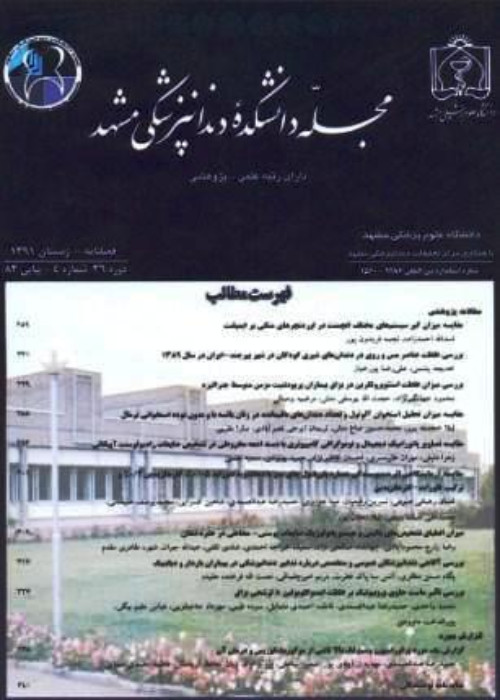Assessment of Oral Health Status and Health Behaviors in the Adult Population of Nomadic Tribes (2016)
Author(s):
Article Type:
Research/Original Article (دارای رتبه معتبر)
Abstract:
Introduction
Nomadic tribes are a population often with low education levels, poor economic status, and limited access to health care. The present study aimed to assess the oral health and oral hygiene behaviors of this specific population.
Materials and Methods
This survey was conducted on 200 participants aged 18-60 years. The subjects were selected via two-stage sampling (convenience and cluster sampling) in Dehestan Ashayeri and Cheshmeh Langan regions in Fereydoon Shahr, Iran in the spring and summer of 2016. Community periodontal index (CPI) and DMFT indices were recorded during dental examination. In addition, oral hygiene behaviors and nutritional habits were recorded in checklists. Data analysis was performed in SPSS version 22 using t-test, Chi-square, and analysis of variance (ANOVA) (α=0.05).
Results
Among the participants, 83 males (41.5%) and 117 females (58.8%) (total: 81.5%; n=163) were selected from Dehestan Ashayeri region, and 18.5% of the subjects (n=37) were selected from Cheshmeh Langan region. According to the findings, 29.1% of the subjects (n=58) never cleaned their teeth, and only 3% reported to brush their teeth daily. Mean of DMFT was 9.6±5.6 (range: 0-28), and 56% and 40% of this index was due to tooth extraction and dental caries, respectively. No significant difference was observed between men and women in terms of DMFT, while a significant difference was denoted between various age groups in this regard (P<0.001). Accordingly, DMFT was 6.7±4.3 in the age group of 18-34 years, 12.5±5.1 in the age group of 35-51 years, and 14.3±5.1 in the age group of 52-68 years. No significant difference was observed in the DMFT between the age groups of 35-51 and 52-68 years. Moreover, codes zero and one were frequent in 2% (n=4) and 29.5% of the subjects (n=59), while 61% (n=123) and 7% of the subjects (n=14) were codes three and four, respectively.
Conclusion
According to the findings, dental caries is highly prevalent in the nomadic tribes of Fereydoon Shahr, and most of the dental referrals of this population are for tooth extraction. Furthermore, a high percentage of the subjects reported gingival bleeding. Based on the periodontal and edentulous health status of these individuals, their oral health status was considered poor compared to the general populationKeywords:
Language:
Persian
Published:
Journal of Mashhad Dental School, Volume:42 Issue: 4, 2019
Pages:
307 to 319
magiran.com/p1909455
دانلود و مطالعه متن این مقاله با یکی از روشهای زیر امکان پذیر است:
اشتراک شخصی
با عضویت و پرداخت آنلاین حق اشتراک یکساله به مبلغ 1,390,000ريال میتوانید 70 عنوان مطلب دانلود کنید!
اشتراک سازمانی
به کتابخانه دانشگاه یا محل کار خود پیشنهاد کنید تا اشتراک سازمانی این پایگاه را برای دسترسی نامحدود همه کاربران به متن مطالب تهیه نمایند!
توجه!
- حق عضویت دریافتی صرف حمایت از نشریات عضو و نگهداری، تکمیل و توسعه مگیران میشود.
- پرداخت حق اشتراک و دانلود مقالات اجازه بازنشر آن در سایر رسانههای چاپی و دیجیتال را به کاربر نمیدهد.
In order to view content subscription is required
Personal subscription
Subscribe magiran.com for 70 € euros via PayPal and download 70 articles during a year.
Organization subscription
Please contact us to subscribe your university or library for unlimited access!


